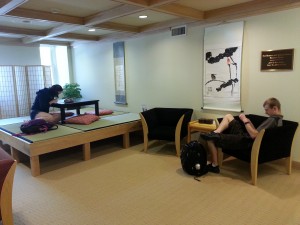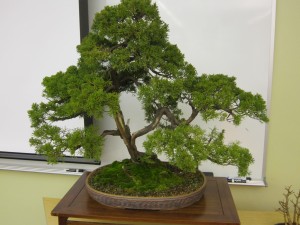Luce Initiative on Asian Studies and the Environment
Recent renovations to the Stern basement have found this screen enjoying new celebrity as the centerpiece of the new Japanese lounge. Complete with grass mats and a stone fountain, this space new space exhibits this beautiful piece in feng shui alignment.
From “New Lives for Asian Images,” by Professors David Strand and Samuel K. Parker:
Court ladies in colorful kimonos are shown enjoying an outing in early spring. According to Professor Alex Bates, this screen, in Yamato-e style, is a copy of the Sumiyoshi monogatari emaki, a Kamakura period picture scroll. The upper half of the painting, including gold cloud formations, was added by the artist to extend the vertical dimension in a manner appropriate to a screen. The original scroll tells the story of a young girl, Himegimi, whose stepmother threatens her marriage prospects. In the scenes depicted here, Himegimi and her entourage are picking young pines in a ritual celebrating spring. An aristocrat of the Shosho rank discovers Himegimi’s beauty despite the efforts of the step-mother to hide her away. As he spies upon Himegimi (from the lower left of the panel), the young man composes a poem:
The spring mists,
veiled the moor,
Yet I went out
and glimpsed this day
the young green of the pine
The Shosho alludes to the difficulty of seeing Himegimi and compares the beauty of the maiden to that of the young pines. Nature imagery conveys meaning in a fashion characteristic of classical Japanese poetry. The placement of male and female figures creates a strong impression of gendered space and emphasizes the transgressive nature of the Shosho’s gaze.
The size and design of his screen suggests that it was once owned by a wealthy Edo merchant. Incoking an aristocratic culture pre-dating samurai rule, the artist and his patron celebrate an ancient, golden age of taste and refinement imagined to outshine the Tokugawa present.


